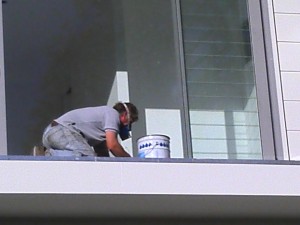
The two different ways that water is retained on the floor and the walls means different waterproofing requirements – the floor needs to be a waterproof construction and the majority of the wall area only needs to be a water resistant construction. Due to the potential for vertical cracking in the internal corners of the wall, there is a requirement to waterproof to a height of 1800 mm above the floor level of the shower. The junction of the wall and the floor also needs to be waterproofed. One should also consider possible flooding of the shower base if the waste outlet from the shower becomes blocked. To prevent flooding through the wall-floor junction there is a requirement to extend the floor waterproofing up the walls to a minimum height of 150 mm or 25 mm above the maximum water level that can be retained within the shower area. This retention height needs to include any extension that is provided by the sill of the shower screen door. The minimum requirements for the treatment of a shower area as specified in AS 3740 are shown in Figure 6. People often ask: “Why not waterproof the whole wall area?” As I remarked at the beginning, the requirements in AS 3740 are the minimum needed to meet the performance clause in the BCA and there are different performance requirements for the floor and the walls. This difference in performance requirement is also recognised in the tiling standards AS 3958.1-2007 Ceramic Tiles Part 1: Guide to installation of ceramic tiles and AS 2358-1990 Adhesives for fixing ceramic tiles. Both tiling standards have different requirements for adhesives used for floor and wall tiles, with the floor tile adhesive needing to be more durable in long-term moist conditions. So, both the tiling standards and the waterproofing standard are in agreement with the different requirements needed for the walls and floor of a shower. There is also a further benefit to not having the requirement to have a membrane treatment over the whole wall area. Currently AS 2358 does not include adhesive testing onto the surface of membranes, only to the materials used for tiling substrates. Therefore, having the tiling substrate exposed over the major part of the wall area enables any wall tile adhesive passing the test requirements of AS 2358 to be used with confidence. With no Australian Standard test criteria currently available for bond strength onto a membrane surface for tiling adhesives, any current specification decision that requires bonding onto the surface of a membrane can only be based on manufacturers’ recommendations. Finally, there is the requirement for any shower screen used to retain water within the shower area. Issues to do with shower screen design and installation were discussed in my article ‘Whole floor waterproofing of bathrooms on timber floor substrate’ in issue 46 (Dec/Feb 2006, page 88). Due to the problem of leaking through frameless glass screens, AS 3740 classifies a shower using this type of screen as needing to be waterproofed as an unenclosed shower. Provided the waterproofing of a shower is done in accordance to AS 3740, and any screen used contains water within the shower area, then damage from leaking showers should be a thing of the past.
https://en.wikipedia.org/wiki/Waterproofing
